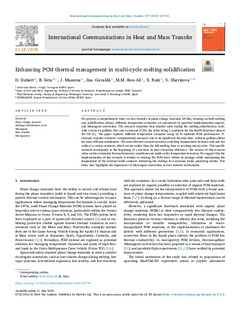Título
Enhancing PCM thermal management in multi-cycle melting-solidificationFecha de publicación
2024Otras instituciones
Technical University of DenmarkUniversitat Rovira i Virgili
Versión
Version publicadaTipo de documento
ArtículoArtículoIdioma
InglésDerechos
© 2024 The AuthorsAcceso
Acceso abiertoVersión de la editorial
https://doi.org/10.1016/j.icheatmasstransfer.2024.107741Publicado en
International Communications in Heat and Mass Transfer Vol. 157. N. art. 107741. September, 2024Editorial
ElsevierPalabras clave
Phase change materials
Melting/solidification cycle
Marangoni effect
Heat transfer ... [+]
Melting/solidification cycle
Marangoni effect
Heat transfer ... [+]
Phase change materials
Melting/solidification cycle
Marangoni effect
Heat transfer
Microgravity [-]
Melting/solidification cycle
Marangoni effect
Heat transfer
Microgravity [-]
Clasificación UNESCO
Transferencia de calorResumen
We present a comprehensive study on heat transfer in phase-change materials (PCMs), focusing on both melting and solidification phases, different temperature scenarios, an assessment of practical impl ... [+]
We present a comprehensive study on heat transfer in phase-change materials (PCMs), focusing on both melting and solidification phases, different temperature scenarios, an assessment of practical implementation aspects, and Marangoni convection. The research examines heat transfer rates during the melting-solidification cycle, with a focus on gallium (Ga) and n-eicosane (C20), the latter being a candidate for the MarPCM project aboard the ISS [1]. The paper explores different temperature scenarios using Ga to optimize PCM performance. N-eicosane requires extensive computational resources due to its significant thermal time, whereas gallium allows for more efficient simulations. The most effective scenario involves switching temperatures between cold and hot walls at a certain moment, which occurs earlier than the full melting time or reaching steady state. This specific moment corresponds to the beginning of a decrease in heat extraction efficiency. The success of this scenario relies on the symmetric thermal boundary conditions and multi-cyclic temperature inversion. We suggest that the implementation of this scenario is similar to rotating the PCM body within its package while maintaining the temperature of the external walls constant. Extending the strategy to n-eicosane yields promising results. This study also highlights the importance of Marangoni convection in heat transfer mechanisms. [-]
Colecciones
- Artículos - Ingeniería [763]
El ítem tiene asociados los siguientes ficheros de licencia:






















